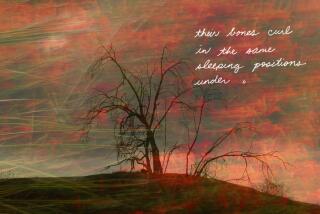Review: Beck’s ‘Song Reader’ inspires creative interpretations
- Share via
Some ideas that seem so simple unleash waves of creativity that expand in exquisitely complex ways. One such musical brainstorm is to offer a new body of work as notated sheet music, as Los Angeles songwriter Beck Hansen has done.
His new work, “Song Reader,” consists of 20 new pieces that the artist hasn’t recorded. Rather, he teamed with the book publisher McSweeney’s to unveil the songs in notated form. It is designed as a folio, and the hope is that the individually illustrated songbooks included within will inspire other musicians to interpret the written music and then share it.
It was, describes writer Jody Rosen in the liner notes, “an experiment in ventriloquism”: Provide the melodic and lyrical dialogue, but leave the aesthetic voice to strangers, who would head to parlors both real and virtual to perform the results.
GRAPHIC: Times music staff best of 2012 list
The temptation is to call the idea revolutionary — except that a century ago sheet music was, in Rosen’s words, “the original pop music technology.” Before the rise of the first commercial recordings in the late 1800s, “audiences experienced popular music first and foremost as a participatory activity,” the writer explains. Hit songs sold millions and became viral on printed paper sold at music stores.
Since it was issued in early December, “Song Reader’s” tunes have sprung from the pages thanks to the wide array of musicians who took the challenge, performed the songs and uploaded them onto the Internet. The results follow a lyrical suggestion implicit in a couplet in the first verses of “Song Reader”: to “Turn Tin Pan Alley into a boulevard and go whistling past a graveyard.”
The bounty, versions of songs such as “Saint Dude,” “Rough on Rats,” “Now That Your Dollar Bills Have Sprouted Wings,” “Mutilation Rag” and others, can be found primarily in three places online: YouTube, Soundcloud and at Songreader.net. The last is the project’s official portal into the myriad renditions.
Best of 2012: Movies | TV | Pop music | Jazz | Video Games| Art | Theater | Dance | Classical music
Sorting through them is as thrilling as it is instructive. Search Soundcloud for “Song Reader” and renditions pop up from across the globe. London record store Rough Trade sponsored an evening of in-store performances by pros such as Ed Harcourt and Steve Mason of the Beta Band. Magnetic Fields’ Stephin Merritt tackled “Old Shanghai,” and writer Kurt Andersen’s radio show “Studio 360” gathered a band into its studios to do “Saint Dude.” (Andersen played the glockenspiel.) Most important, countless amateur musicians have added voice.
At music service Soundcloud, hundreds of “Song Reader” versions have popped up, where after a search you can compare and contrast musical sensibilities. An artist named Double B. Harry for his “Now That Your Dollar Bills Have Sprouted Wings” created a take inspired by Beck’s electro-funky “Midnite Vultures” phase. The Portland Cello Project interpreted the same song with an instrumentation and pace that suggests Beck’s gentler, country-inspired “Mutations” work. Each rendition adds new flair, arrangements, textural ideas. And with no “official” Beck recording on which to base interpretations, the same notes arrive through fiddles and synthesizers with equanimity, with no right or wrong answer.
For 21st century technologists, the project is equally fascinating. Because Beck offered a specific song sequence, “Song Reader” allows for hand-designed playlists: I’ve ordered both Soundcloud and YouTube playlists based around the “Song Reader” track list that, combined, are as melodically and lyrically evocative as any Beck record since “Sea Change.” These are really good songs.
As time passes and more people upload versions to YouTube — and a musician’s lack of music-reading skills is rendered moot by an ability to learn the songs by ear — the myriad uploads will allow for hand-designed “Song Reader” versions: A electronic version a la “The Information.” A country blues collection suggesting “One Foot in the Grave.”
And, finally, for those like myself who don’t read music, the McSweeney’s publication is a valuable entry point. It’s as though we’d been given a series of puzzles on intricately crafted pages — a secret language with hints at its translation — designed by masters of both song and design. “Song Reader” allows us to sing along while we try to figure out the code (and codas).
On the back page of Rosen’s fantastic essay, in fact, is a primer called “A Guide to Sheet Music Symbols” that in simple illustrated form explains the meanings of various symbols and definitions of important notation ideas. By the end, you’ll understand the difference among a “slur,” “legato” and “coda,” when to repeat a phrase and how to swing and shuffle a series of notes.
Combined, it’s a wildly successful creation, one that connects the mass-distributed paper past and the interconnected present. And perhaps most impressive, “Song Reader” will continue to evolve, a fluid mass of melodic ideas floating through time and space.
PHOTOS AND MORE
PHOTOS: Iconic rock guitars and their owners
The Envelope: Awards Insider
PHOTOS: Grammy top nominees
More to Read
The biggest entertainment stories
Get our big stories about Hollywood, film, television, music, arts, culture and more right in your inbox as soon as they publish.
You may occasionally receive promotional content from the Los Angeles Times.










